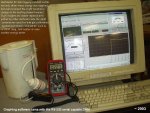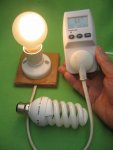Hi,
I've compared a few devices similar to this and found them on average to be quite poor in resolution and or accuracy. An efergy meter I tried was laughable, it's readings actually in some tests (reactive) went down when the load was increased, the manufacturer didn't respond to my questions on either accuracy, resolution or if I simply had a duff unit. I wonder why.
Trying to measure the current flowing through a wire without actually being in line is horrendously difficult to do with any degree of accuracy. And not at this sort of price point. I've got some honeywell clip current transformers that cost more than this unit alone and they have proved to be of no real use.
What we all have are the meters the local power company provide. These whether accurate or not (not my debate but are certainly better than any of these devices) are at least what we are being charged by so is 100% accurate with your bill.
Reading the actual meter is actually a much better thing to do.
If your meter has a flashing pulse LED output, 1000 per/Kw is normal, than the greatest resolution per second is 60w, 1w over a minute etc, and can be read by a pixace and maplin components that'll cost you less than ?1. I'm working on one currently that?s visually sensitive enough for analog meters (those without reflective dials on 6 or 0 like mine), still only a few ?'s of components though.
We are currently implementing a per device meter that's to class 1 meter specs 1/2% allowable error (active/reactive), it's going to be around ?90 so that gives you an idea of what is possible within the realms of ?29-?49 pounds.
The best you can hope for is a bit like a VU meter for sound, when it goes up it's usually true and down also, but because it's got numbers, don't expect them to be accurate, linear or actually indicative of the truth

If anyone would like circuits etc posting for the meter readers just shout and I'll spend some time doing a brief piece on it.
After a re-read sounds like I'm really down on these smart meters, I'm not, just get fed up of people selling things that fail to deliver something close to expectation

Miles
________
starcraft replays



